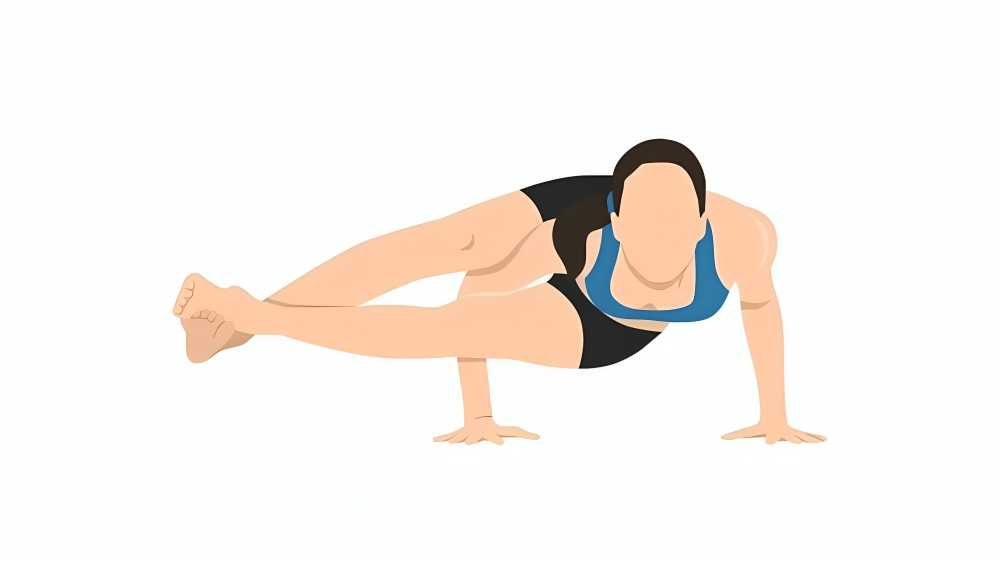
What is Astavakrasana
There is Astavakrasana, named after the sage Astavakra. This pose that balances the body on its arms combines high challenges with great rewards: there must be an excellent balance of core strength, flexibility, and mental focus. “Asta” is “eight” in Sanskrit, while “vakra” means bent or curved, and the name refers not only to the eight limbs involved in the pose but also to the twist of the torso.
It’s indeed an advanced yoga posture, but patience and proper progression may lead even intermediate practitioners toward achieving it.
How to Do Astavakrasana
Warm-up First
You need to warm up your body, particularly the wrists, shoulders, and hips, before making an attempt at Astavakrasana. Do some poses from this category like Downward Dog, Plank Pose, Crow Pose (Bakasana), and Seated Forward Bend (Paschimottanasana) before doing this pose.
Begin by being Seated
Begin sitting on your mat with your legs extended in front of you.
Bend your right knee and cross your right foot over your left thigh near your left hand. You are to position yourself as much as possible like in a seated half-lotus position.
Bring your arm through as if you were threading the sleeve of a shirt under the bent leg.
Lift your right leg a little, and slide your right arm under the right knee. Supporting your thigh with the upper arm nearest to the shoulder, let your left leg straight out.
Cross Your Ankles
Place your right leg on your crook of upper arm with the help of which you push your left leg to cross it over your ankle on the right side. Now it’s time for core engagement.
Lean forward and Balance
Lean your body a little to the front so that both the palms are placed firmly on the ground with fingers spread out for better support.
You lift your hips off the floor. Your legs are crossed and extend straight to the right side. Bring your elbows closer to your body. Try to balance yourself by bringing your shoulders back.
Hold and Breathe
Preserve the posture for 5 to 10 breaths, or for as long as you can.
Gaze somewhere vaguely to focus on conscious, slow breathing to counterbalance your movements and calm yourself down.
Unwind Gradually
To exit, slowly bring your body down to the floor without lowering it, uncross your ankles, and sit back again.
Benefits of Astavakrasana
Core Strength
It’s a great pose for strengthening the core muscles. So, while it keeps the balance and the legs lifted, its abdominal muscles must be engaged, thereby sure to tone the midsection.
Strengthens Arms and Shoulders
As you bear most of your body weight, this asana builds strength in your upper body-that is, in your arms, shoulders, and wrists. You pretty much get a mini bodyweight exercise here!
Greater Balance and Awareness
It takes a huge amount of concentration and focus to balance your entire body on just your hands. As you do this, you will find that mental clarity improves with time, as retaining this pose teaches you how to be in the present and even calming during moments of peak tension.
Flexibility in the Hips and Hamstrings
While twisting your torso, you can lift your legs upwards and it can help open your hips and stretch your hamstrings. The more you practice, the more flexible you will be in order to practice other seated or standing yoga poses.
Confidence Booster
Mastering a pose like Astavakrasana undoubtedly instils in you a huge amount of confidence that you can actually stretch the muscles of your body in ways you never thought you could. The sense of achievement from mastering the pose will encourage you to try even more challenging yoga poses.
Mind-Body Connection
As you attempt to keep this balance and simultaneously breathe very deeply, Astavakrasana is good for cultivating a mind-body relationship. This awareness can be taken to other activities of your life as well, thereby heightening your state of mindfulness and warding off anxiety.
It’s Here Hanumanasana How to Do It And What Are The Benefits
FAQs
Q1: Do I need to have a flexible body to do Astavakrasana?
No, that’s not necessary, but some hip flexibility is necessary. Preparing the hip with poses such as Pigeon Pose or Garland Pose makes entry into Astavakrasana much more smooth.
Q2: How long will take it to master this pose?
It depends upon everyone, based on your present degree of strength and flexibility. Regularly practicing is when you’ll begin to notice changes by weeks or months.
Q3: Is Astavakrasana accessible for beginners?
Beginners can attempt the preparatory poses but is preferably to build up a foundational strong practice of other arm balances and hip-openers before attempting Astavakrasana.

